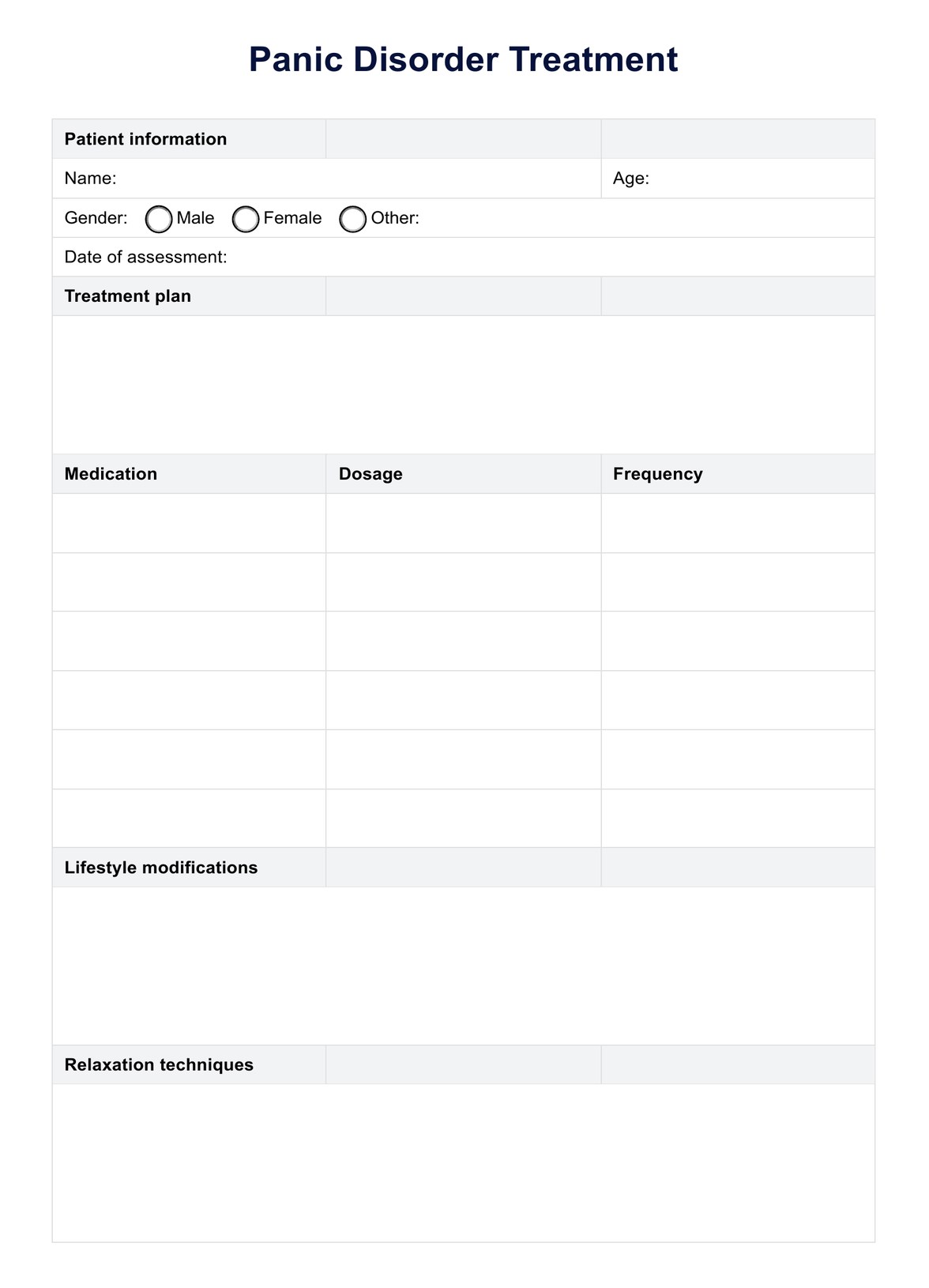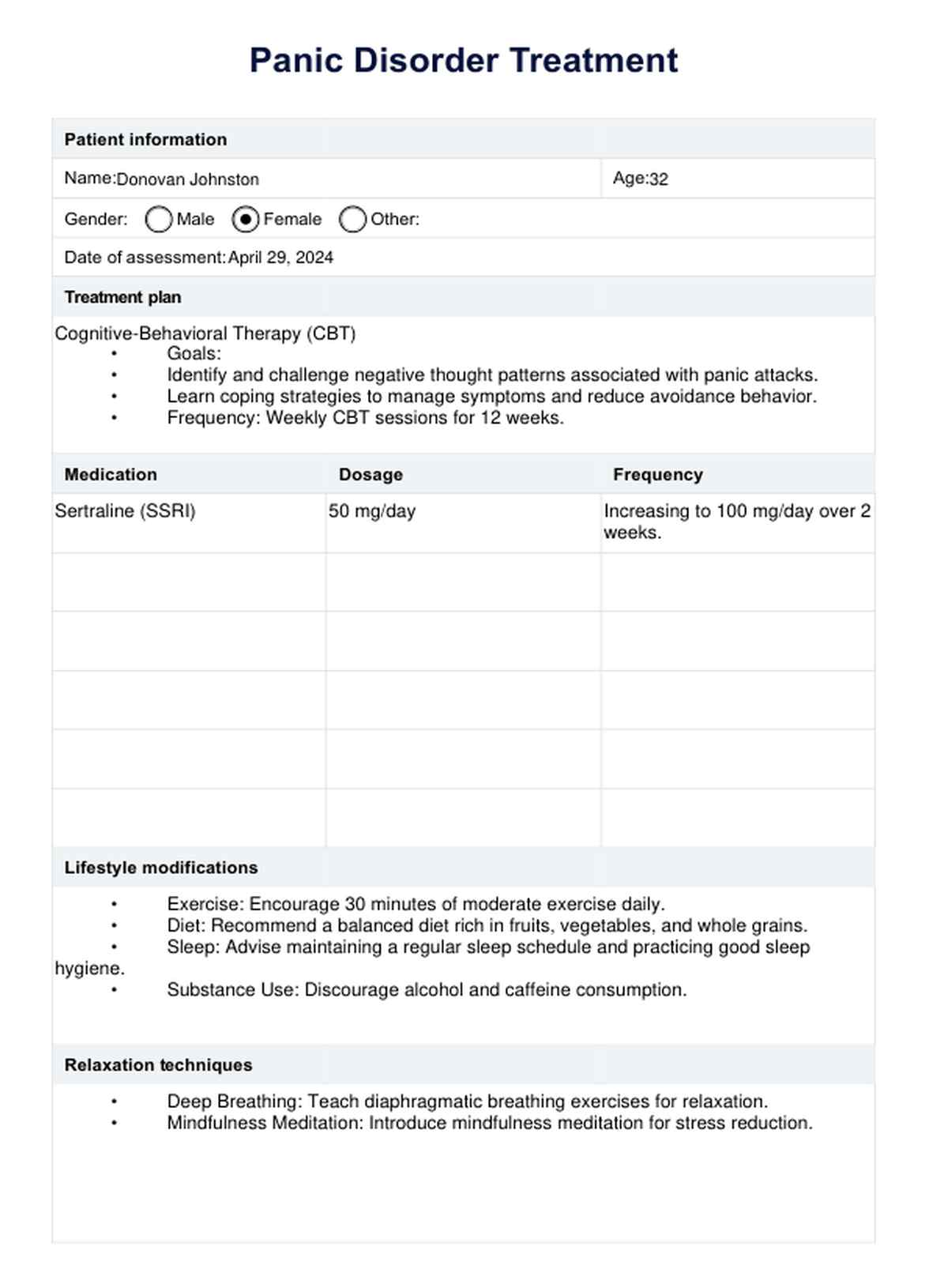Panic Disorder Treatment Template
Download Carepatron's free PDF template and example for panic disorder treatment, to guide you in providing effective treatment for individuals experiencing panic disorder.


What is a panic attack?
A panic attack is an intense and sudden episode of overwhelming fear or anxiety that can strike unexpectedly and without apparent cause. It's a hallmark symptom of panic disorder, a type of anxiety disorder characterized by recurrent and unexpected panic attacks.
During a panic attack, individuals may experience a combination of physical and psychological symptoms. Physical symptoms can include a racing heart, chest pain, shortness of breath, trembling or shaking, sweating, dizziness, and feelings of choking or suffocation. These symptoms can be so severe that they mimic those of a heart attack, leading to heightened distress.
Mentally, individuals may feel a sense of impending doom, a loss of control, or detachment from reality. They may also experience intense fear of dying, going crazy, or losing control.
It's important to recognize that panic attacks are not dangerous in themselves, but they can be distressing and disruptive to daily life. Effective treatment of panic disorder often involves a combination of therapy, such as cognitive-behavioral therapy (CBT), and medication, including selective serotonin reuptake inhibitors (SSRIs) or benzodiazepines.
Seeking support from a mental health professional is crucial to diagnosing the panic disorder scale accurately. With the right treatment and support, individuals can learn to manage and reduce the frequency and severity of panic attacks, ultimately improving their overall mental health and quality of life.
Panic Disorder Treatment Template
Panic Disorder Treatment Template Example
What is the difference between a panic attack and an anxiety attack?
Understanding the distinction between a panic attack and an anxiety attack is essential for accurate diagnosis and effective way to treat panic disorder, especially for individuals dealing with panic disorder or other anxiety symptoms.
A panic attack is a sudden and intense surge of fear or discomfort that reaches its peak within minutes. Panic attack symptoms often occur unexpectedly and can be accompanied by a range of physical severe symptoms, such as a racing heart, sweating, trembling, and shortness of breath. Panic attacks are typically brief but can be extremely distressing, leading individuals to fear that they will lose control or experience a life-threatening situation.
On the other hand, an anxiety attack is a more gradual onset of overwhelming worry or fear that builds up over time. Unlike panic attacks, anxiety attacks are often triggered by specific stressors or situations and may not have as many intense physical symptoms. Instead, individuals experiencing an anxiety attack may primarily feel a sense of unease, restlessness, or impending doom.
While panic attacks are a defining feature of panic disorder, anxiety attacks are not recognized as a distinct clinical diagnosis in the DSM-5. Treatment for both panic attacks and anxiety attacks may involve therapy, such as CBT, and medication, including SSRIs, under the guidance of a mental health professional. Understanding these differences can help individuals and healthcare providers better identify and address the specific challenges associated with panic disorder and other anxiety disorders.
Symptoms of panic disorders
Panic disorders are characterized by recurring and unwarranted panic attacks, accompanied by a variety of physical and psychological symptoms. These symptoms can significantly impact daily functioning and quality of life. Common signs and symptoms of a panic disorder include:
Intense fear or discomfort
Individuals with panic disorder often experience overwhelming feelings of fear or discomfort, which can be disproportionate to any actual threat or danger.
Recurrent panic attacks
A hallmark symptom of panic disorder is the occurrence of recurrent panic attacks. These sudden episodes of intense fear or anxiety can strike unexpectedly and without a clear trigger.
Physical symptoms
Panic attacks are accompanied by a variety of physical symptoms, including a rapid heartbeat, sweating, trembling or shaking, shortness of breath, chest pain or discomfort, nausea, dizziness, and feelings of choking.
Psychological symptoms
In addition to physical symptoms, individuals may also experience psychological symptoms during panic attacks, such as a sense of impending doom, a fear of losing control, a detachment from reality, or a fear of dying.
Avoidance behavior
As a result of the fear of experiencing panic attacks, individuals with complications panic disorder may begin to avoid certain places or situations where they fear an attack may occur. This avoidance behavior can significantly impact daily functioning and quality of life.
Interference with daily life
Panic disorder symptoms can interfere with various aspects of daily life, including work, social relationships, and recreational activities. This interference can lead to significant distress and impairment in functioning.
Co-occurring conditions
It's common for individuals with panic disorder also to experience other mental health issues, such as depression or substance abuse, further complicating their condition and treatment.
How often do unexpected panic attacks occur?
Unwarranted panic attacks can occur sporadically and vary in frequency from person to person. For individuals with panic disorder, these episodes typically occur unpredictably and can range from occasional occurrences to more frequent and debilitating experiences.
Some individuals may experience panic attacks infrequently, perhaps only a few times a year, while others may experience them more frequently, even multiple times a week. Factors such as stress levels, life events, and individual susceptibility to anxiety can influence the frequency of panic attacks.
Additionally, untreated or poorly managed panic disorder may result in more frequent and severe panic attacks.
Seeking support from a mental health professional and exploring treatment options can help individuals reduce the frequency and severity of unexpected panic attacks, ultimately improving their overall quality of life.
Criteria for diagnosis of panic disorder
The Diagnostic and Statistical Manual of Mental Disorders, Fifth Edition (DSM-5), published by the American Psychiatric Association (2013), outlines specific criteria for diagnosing panic disorder. To receive a diagnosis of panic disorder, the patient must have:
A. Recurrent unexpected panic attacks. A panic attack is an abrupt surge of intense fear or intense discomfort that reaches a peak within minutes, and during which time four (or more) of the following symptoms occur:
Note: The abrupt surge can occur from a calm state or an anxious state.
Palpitations, pounding heart, or accelerated heart rate.
- Sweating.
- Trembling or shaking.
- Sensations of shortness of breath or smothering.
- Feelings of choking.
- Chest pain or discomfort.
- Nausea or abdominal distress.
- Feeling dizzy, unsteady, light-headed, or faint.
- Chills or heat sensations.
- Paresthesias (numbness or tingling sensations).
- Derealization (feelings of unreality) or depersonalization (being detached from oneself).
- Fear of losing control or “going crazy.”
- Fear of dying.
Note: Culture-specific symptoms (e.g., tinnitus, neck soreness, headache, uncontrollable screaming or crying) may be seen. Such symptoms should not count as one of the four required symptoms.
B. At least one of the attacks has been followed by 1 month (or more) of one or both of the following:
- Persistent concern or worry about additional panic attacks or their consequences (e.g., losing control, having a heart attack, “going crazy”).
- A significant maladaptive change in behavior related to the attacks (e.g., behaviors designed to avoid having panic attacks, such as avoidance of exercise or unfamiliar situations).
C. The disturbance is not attributable to the physiological effects of a substance (e.g., a drug of abuse, a medication) or another medical condition (e.g., hyperthyroidism, cardiopulmonary disorders).
D. The disturbance is not better explained by another mental disorder (e.g., the panic attacks do not occur only in response to feared social situations, as in social anxiety disorder; in response to circumscribed phobic objects or situations, as in specific phobia; in response to obsessions, as in obsessive-compulsive disorder; in response to reminders of traumatic events, as in posttraumatic stress disorder; or in response to separation from attachment figures, as in separation anxiety disorder).
How is panic disorder treated?
Managing panic disorder involves a multifaceted approach that combines various treatment modalities tailored to individual needs. Here are five standard methods for treating panic disorder:
1. Cognitive-behavioral therapy
CBT is a highly effective psychotherapy approach that helps individuals identify and challenge negative thought patterns and behaviors associated with panic attacks. Through CBT, individuals learn coping strategies to manage panic symptoms and gradually confront feared situations.
2. Medication
Medications, such as SSRIs or benzodiazepines, may be prescribed to alleviate symptoms of panic disorder. SSRIs help regulate serotonin levels in the brain, while benzodiazepines provide short-term relief from acute panic symptoms.
3. Relaxation techniques
Practicing relaxation techniques, such as deep breathing exercises, progressive muscle relaxation, and mindfulness meditation, can help reduce overall anxiety levels and mitigate the onset of panic attacks.
Use the Relaxation Techniques Template to incorporate effective methods for managing stress and anxiety into your practice. This template provides a structured approach to various relaxation strategies, including deep breathing, progressive muscle relaxation, and guided imagery.
4. Lifestyle modifications
Making healthy lifestyle choices, such as maintaining a balanced diet, regular exercise regimen, adequate sleep, and avoiding substance abuse, can contribute to overall well-being and reduce the frequency of panic attacks.
5. Support groups
Participating in support groups or group therapy sessions with individuals experiencing similar challenges can provide validation, encouragement, and practical coping strategies for managing panic disorder.
Reference
American Psychiatric Association. (2013). Anxiety disorders. In Diagnostic and Statistical Manual of Mental Disorders (5th ed., Vol. 5, Issue 5). https://doi.org/10.1176/appi.books.9780890425596
Commonly asked questions
Cognitive behavioral therapy (CBT) for panic disorder helps individuals identify and challenge negative thought patterns and behaviors associated with panic attacks. It teaches coping strategies to manage symptoms and gradually confront feared situations.
Regular exercise, maintaining a balanced diet, adequate sleep, avoiding substance abuse, and practicing stress-reduction techniques like mindfulness can support the treatment of panic disorder.
Yes, panic disorder can increase the risk of developing other mental health conditions such as depression, agoraphobia, and substance abuse disorders.





















-template.jpg)


















































































